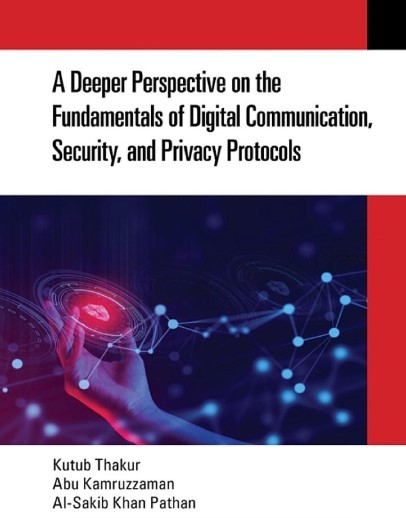lead authored by Dr. Kutub Thakur, New Jersey City University, Professional Security Studies Department

The book titled “A Deeper Perspective on the Fundamentals of Digital Communication, Security, and Privacy Protocols” authored by Dr. Kutub Thakur, Dr. Abu Kamruzzaman and Dr. Al-Sakib Khan Pathan was published with the CRC press on June 30th, 2022. This book describes the detailed concepts of Digital Communication, Security, and Privacy protocols. This book is an “easy-read” volume that makes complicated issues about communication, security, and privacy protocols easily accessible even to the general readers. The book can be used as a textbook both for graduate studies and undergraduate classes. Different chapters or parts of a chapter of this book can also be used by undergraduates, graduates or doctoral students for their research works in the academia or by the researchers in established laboratory environments. The industry professionals and practitioners can also greatly benefit by diving deep into the concepts and practices from the various topics of this book.
The book is divided into three major components. The first component is a deeper perspective on communication with a highlight of the Analog and Digital Communication Networks and Protocols. The second component focuses on the details of Digital Communication Protocols with a highlight on the major Telephony Protocol, Data Communication Protocols, Wireless and Cellular Communication Protocols, and Fiber Optic Data Transmission Protocols. The final component features on Digital Security and Privacy Protocols with the focus on the Network Security Protocols, Wireless Security Protocols, Server Level Security Systems, and various aspects of privacy related to communication protocols. At the end of each chapter of the book, there are sample questions and answers for readers to better understand on the related concepts discussed in each chapter in the book.
The highlights on the Communication protocol are a set of predefined rules and laws used for establishing meaningful communication between sender and receiver of the signals. The communicating nodes are commonly referred to as the transmitter and the receiver. A history of communication with the detailed explanation of different types of signals starting with visual signals dated back in 1792. After explaining all the signals, the authors focus on multiple waves used in communication. Authors introduce Open Systems Interconnection(OSI) Model in the form of communication. After the OSI discussion the types of modulations in communication with the details of each of these modulations are explained. Multiple types of multiplexing are covered in the rest of the chapter of the book. The analog communication protocol chapter explanation starts with the Telegraph Protocols and ends with the Circuit Switching. The Digital Communication Protocols chapter begins with the Digital Telephone Switching Techniques and ends with the X.21 Protocol.
Major digital telephony communication protocols were initially designed and developed for analog telephony systems, but later, those protocols were modified and upgraded for digital telephony use. Major digital telephony communication protocols chapter begins with Pulse Code Modulation commonly referred to as PCM, is a type of modulation, which is extensively used in
telephony systems across the world. It is extensively used in narrowband as well as in broadband data communication. The chapter ends with the detail explanation on the “E.164 Standard” designed and developed by the ITU for the international telephone numbering scheme or plan. Prior to this standard, the numbering plan for the worldwide telephony network was based on the E.163 standard, which was superseded by the E.164 standard for the international numbering scheme.
Data communication is a modern domain of communication in which the digital data is transmitted between a source and a destination or a sender and a receiver through different types of media such as copper wire, fiber optics, computer buses, electronic circuits, storage devices, and wireless channels. The entire data communication – point-to-point or point-to-multipoint – is governed by different communication protocols. Those protocols are known as data communication protocols. The data communication protocols chapter focus on the different types of modern data communication protocols that work either at network and upper layers (application-specific) protocols such as routing protocols, transport protocols, and other application-specific protocols that are used by the modern data services in the environment of the latest Internet-based technologies.
A set of rules used by the sender and receiver devices of the wireless communication systems to understand and recover the data transported over the wireless channel such as air or vacuum is known as the wireless telecommunication protocol.
Fiber optic transmission has become very popular in modern telecommunication systems due to its higher capacity and no electromagnetic interference. Fiber optic is being used in all types of networks such as metro fiber networks, last-mile networks, backbone networks, inter-continent networks, and others. Numerous types of fiber optic transmissions and multiplexing protocols have got deeper traction in the telecommunication sector.
Fiber Optic Data Transmission Protocols chapter the discussion is on some very important fiber optic transmission/communication protocols extensively used in the modern telecom sector.
Digital Security and Privacy Protocols section highlights on Network Security Protocols, Wireless Security Protocols, with different types of Server Level Security Systems
Finally, Privacy discussion begins with the difference between Privacy and Security with multiple types with privacy related to human and computer usage.
The book is designed for the users to benefit from a detail knowledge about data, analog and digital communication networks, protocol, routers with a step-by-step guide to analogue and digital communication protocols and its importance in the modern world and major communication technology related threats and their impact on the world. The book also details on how to maintain the privacy on the cyberspace when using multiple devices with an overview of the major security and privacy protocols with guidelines on how to secure the devices more effectively and an awareness on how to make your online presence more secure and reliable. The book also guides a user in detail about what to do and what not to do in the digital network environment to maintain the security of your privacy and resources.
Link: https://www.routledge.com/A-Deeper-Perspective-on-the-Fundamentals-of-Digital-Communication-Security/Thakur-Kamruzzaman-Pathan/p/book/9781032292922